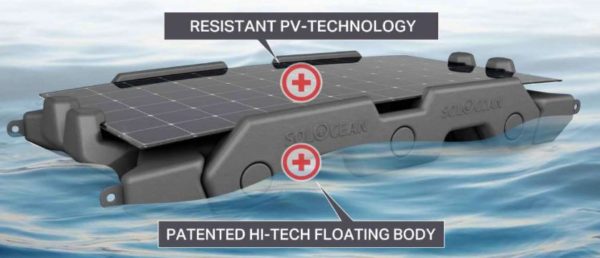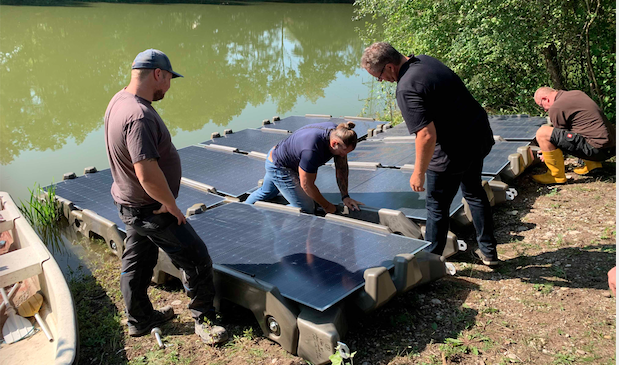Austrian technology company SolOcean GmbH Austria has unveiled its new mounting structure for floating PV arrays, a floater made of UV-stable HDPE plastic.
“After eight years of research and around €1 million of private investment in the development of a floating photovoltaic system, SolOcean has now successfully launched a finished system into the water for the first time,” the company said in a statement, noting that the first floating system based on its technology is currently being tested on a quarry pond in Pöchlarn in Lower Austria.
The floating structure was assembled by Austrian company Rehau GmbH with decentrally manufactured components. It measures 2,130 x 1,100 x 300 mm and weighs 48 kg. It can host a PV element with dimensions of 210 x 1,034 x 8 mm and a power of output of up to 445 W, and reach with it a weight of up to 69 kg.
“The floater can host, in principle, any kind of solar module,” the company's CFO, Marcus Ransauer, told pv magazine. “But the special glass surface we developed is necessary to avoid salt furring and furring from bird-dropping. So, the customer buys the whole system at SolOcean, but SolOcean can choose the supplier for the module and the glass. These components are then assembled together in the SolOcean floater.”
The floating structure can be anchored to the seabed with a mooring line and, if used with a solar module with a power output of 445 W, the required area per megawatt would reach 5,995 m2.

Image: SolOcean
The ideal PV element can be a solar module with a power output ranging from 430 to 445 W, which weighs 25 kg and is made with 2 mm tempered glass, hydrophobic coating, and polyolefin foil as an encapsulant. A single module has a buoyancy of 430 kg.
The panel should operate with a maximum system voltage of 1.050 V and operating temperatures of between -40 and 90 degrees Celsius; its operating temperature coefficient is -0.37% per degree Celsius.
The floater comes with a 15-year warranty and is claimed to be suitable for waves up to 3m and currents up to 2m/sec. According to the manufacturer, it can be used either for onshore and offshore applications, as it was also conceived to be salt-resistant.
“Everything is designed for use under extreme conditions,” it further explained, noting that the hydrophobic coating acts against adhering salt crystals and bird droppings, preventing the adherence of organic substances on the module surface.
This content is protected by copyright and may not be reused. If you want to cooperate with us and would like to reuse some of our content, please contact: editors@pv-magazine.com.




By submitting this form you agree to pv magazine using your data for the purposes of publishing your comment.
Your personal data will only be disclosed or otherwise transmitted to third parties for the purposes of spam filtering or if this is necessary for technical maintenance of the website. Any other transfer to third parties will not take place unless this is justified on the basis of applicable data protection regulations or if pv magazine is legally obliged to do so.
You may revoke this consent at any time with effect for the future, in which case your personal data will be deleted immediately. Otherwise, your data will be deleted if pv magazine has processed your request or the purpose of data storage is fulfilled.
Further information on data privacy can be found in our Data Protection Policy.